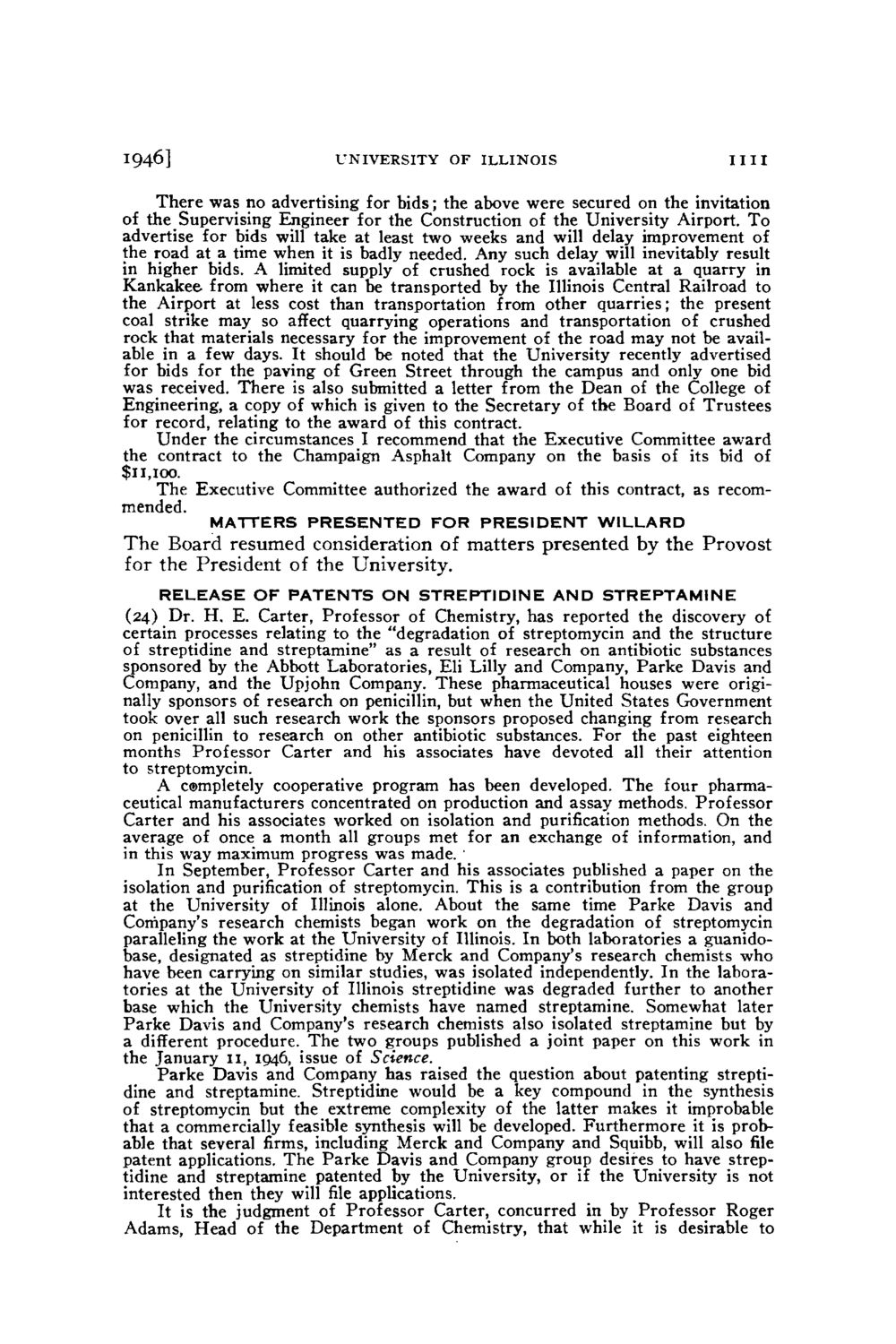| |
| |
Caption: Board of Trustees Minutes - 1946
This is a reduced-resolution page image for fast online browsing.

EXTRACTED TEXT FROM PAGE:
1946] UNIVERSITY OF ILLINOIS IIII There was no advertising for b i d s ; the above were secured on the invitation of the Supervising Engineer for the Construction of the University Airport. T o advertise for bids will take at least two weeks and will delay improvement of the road at a time when it is badly needed. Any such delay will inevitably result in higher bids. A limited supply of crushed rock is available at a quarry in Kankakee from where it can be transported by the Illinois Central Railroad to the Airport at less cost than transportation from other quarries; the present coal strike may so affect quarrying operations and transportation of crushed rock that materials necessary for the improvement of the road may not be available in a few days. It should be noted that the University recently advertised for bids for the paving of Green Street through the campus and only one bid was received. There is also submitted a letter from the Dean of the College of Engineering, a copy of which is given to the Secretary of the Board of Trustees for record, relating to the award of this contract. Under the circumstances I recommend that the Executive Committee award the contract to the Champaign Asphalt Company on the basis of its bid of $II,IOO. The Executive Committee authorized the award of this contract, as recommended. MATTERS PRESENTED FOR PRESIDENT WILLARD T h e Board resumed consideration of matters presented by the Provost for the President of the University. RELEASE OF PATENTS ON STREPTIDINE AND STREPTAMINE (24) Dr. H . E. Carter, Professor of Chemistry, has reported the discovery of certain processes relating to the "degradation of streptomycin and the structure of streptidine and streptamine" as a result of research on antibiotic substances sponsored by the Abbott Laboratories, Eli Lilly and Company, P a r k e Davis and Company, and the Upjohn Company. These pharmaceutical houses were originally sponsors of research on penicillin, but when the United States Government took over all such research work the sponsors proposed changing from research on penicillin to research on other antibiotic substances. F o r the past eighteen months Professor Carter and his associates have devoted all their attention to streptomycin. A c®mpletely cooperative program has been developed. T h e four pharmaceutical manufacturers concentrated on production and assay methods. Professor Carter and his associates worked on isolation and purification methods. On the average of once a month all groups met for an exchange of information, and in this way maximum progress was made. ' In September, Professor Carter and his associates published a paper on the isolation and purification of streptomycin. This is a contribution from the group at the University of Illinois alone. About the same time P a r k e Davis and Company's research chemists began work on the degradation of streptomycin paralleling the work at the University of Illinois. In both laboratories a guanidobase, designated as streptidine by Merck and Company's research chemists who have been carrying on similar studies, was isolated independently. In the laboratories at the University of Illinois streptidine was degraded further to another base which the University chemists have named streptamine. Somewhat later P a r k e Davis and Company's research chemists also isolated streptamine but by a different procedure. T h e two groups published a joint paper on this work in the January 11, 1046, issue of Science. P a r k e Davis and Company has raised the question about patenting streptidine and streptamine. Streptidine would be a key compound in the synthesis of streptomycin but the extreme complexity of the latter makes it improbable that a commercially feasible synthesis will be developed. F u r t h e r m o r e it is probable that several firms, including Merck and Company and Squibb, will also file patent applications. T h e P a r k e Davis and Company group desires to have streptidine and streptamine patented by the University, or if the University is not interested then they will file applications. It is the judgment of Professor Carter, concurred in by Professor Roger Adams, Head of the Department of Chemistry, that while it is desirable to
| |